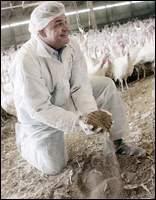



Turkeys Fuel 1st U.S. Poultry Litter Electric Plant
US - The gray, sandy mix of turkey droppings and other bits and pieces flowing through Greg Langmo’s fingers back onto the floor of his barn isn’t just funky dirt, it’s fuel. |
| Greg Langmo holds a new source of alternative energy, a mix of turkey droppings and other bits and pieces, May 2 on his turkey farm near Litchfield, Minn. |
With 16,000 hens gobbling around him, Langmo is standing on a 15-inch layer of turkey litter — some 750 tons — that represents a new source of energy.
It will help fuel a $200 million power plant due to begin full-scale production next month. The 55-megawatt Fibrominn LLC plant will be the first poultry litter-fired power plant in the United States, tapping a novel source of renewable energy to produce enough power for 50,000 homes. Its developers are planning similar plants in other major poultry states.
Poultry litter has long been spread on fields as a fertilizer. That’s cheap and effective, but it can cause nitrates and phosphates to build up in soil, groundwater and runoff. So poultry producers across the country have been looking for another way to get rid of it.
“We’ve got a long-term, economically and environmentally sustainable alternative to land-spreading — the only advancement in manure management technology since the development of the spreader,” said Langmo, a turkey farmer and fuels manager for Fibrominn.
The poultry industry’s dilemma created an opportunity for Fibrowatt Ltd., which developed three smaller poultry litter power stations in Britain in the 1990s. As it happens, Minnesota is the nation’s largest turkey-producing state.
When the state’s producers learned about Fibrowatt, farmers and local officials began an intensive courtship of the company. At the same time, Minneapolis-based Xcel Energy Inc. was looking for new sources of renewable energy to comply with a mandate imposed by the Minnesota Legislature that requires it to get 110 megawatts of power from biomass annually.
Source: Rockford Register Star











